高一英语语法(4):动词的被动语态
高中英语知识点归纳被动语态和主动语态的区别总结

高中英语知识点归纳被动语态和主动语态的区别总结被动语态和主动语态是英语中常用的两种语态之一,它们在表达方式和语法结构上有着明显的差异。
本文将对被动语态和主动语态进行总结和区别,并提供一些学习和应用被动语态的技巧。
一、被动语态的定义和结构被动语态是指动作的承受者或对象成为句子的主语,强调的是动作对主语的影响或作用。
被动语态的结构为“助动词be + 过去分词”。
具体的构成如下:1. 一般现在时的被动语态:主语 + am/is/are + 过去分词2. 一般过去时的被动语态:主语 + was/were + 过去分词3. 一般将来时的被动语态:主语 + will be + 过去分词二、主动语态的定义和结构主动语态是指主语执行动作,强调的是主语的行为或动作。
主动语态的结构为“主语 + 动词 + 宾语”。
具体的构成如下:1. 一般现在时的主动语态:主语 + 动词 + 宾语2. 一般过去时的主动语态:主语 + 动词的过去式 + 宾语3. 一般将来时的主动语态:主语 + will + 动词原形 + 宾语三、被动语态和主动语态的区别被动语态和主动语态在语法结构和句子表达上有明显的差异,其主要区别如下:1. 句子结构:- 被动语态:助动词be + 过去分词- 主动语态:主语 + 动词 + 宾语2. 语气和重点:- 被动语态:强调动作的承受者或对象- 主动语态:强调动作的执行者或主体3. 形式和动作:- 被动语态:动作对主语的影响或作用- 主动语态:主语执行动作4. 时态和人称:- 被动语态和主动语态的时态和人称要保持一致,只是在结构上有所差异四、学习和应用被动语态的技巧1. 注意动词的时态:- 在使用被动语态时,要根据句子的时态来确定助动词be的形式,如一般现在时用am/is/are,一般过去时用was/were,一般将来时用will be。
2. 确定句子的主语和宾语:- 在转换为被动语态时,要注意确定原句中的主语和宾语,将宾语变为被动结构中的主语,同时动词也要做相应的调整。
高中英语被动语态知识点

高中英语被动语态知识点语态也是动词的一种形式,表示主语与谓语之间的关系。
英语有两种语态:主动语态(active voice) 和被动语态(passive voice)。
主动语态表示主语是谓语动作的执行者,而被动语态则表示主语是谓语动作的承受者。
下面小编给大家分享一些高中英语被动语态知识,希望能够帮助大家,欢迎阅读!高中英语被动语态知识十种常见时态的被动语态1. 一般现在时主动语态:do被动语态:am is are doneWe clean the classroom every day. 我们每天打扫教室。
The classroom is cleaned by us every day. 教室每天都由我们打扫。
Such songs are usually sung by girls. 这些歌通常是女孩子们唱的。
Russian is not taught in our school. 我们学校不教俄语。
Are many goods shipped abroad every day 每天都有许多货物运往国外吗2. 一般过去时主动语态:did被动语态:was were doneWe cleaned the classroom yesterday. 昨天我们打扫了教室。
The classroom was cleaned by us yesterday. 昨天教室被我们打扫了。
The window was broken by my son. 窗子是我儿子打破的。
Were many trees planted on the hill yesterday 昨天山上种了许多树吗?How much money was stolen in all 一共被偷了多少钱?3. 一般将来时主动语态:will shall do被动语态:will shall be doneWe will clean the classroom soon. 我们很快要打扫教室。
高中英语知识点归纳被动语态的构成和用法总结
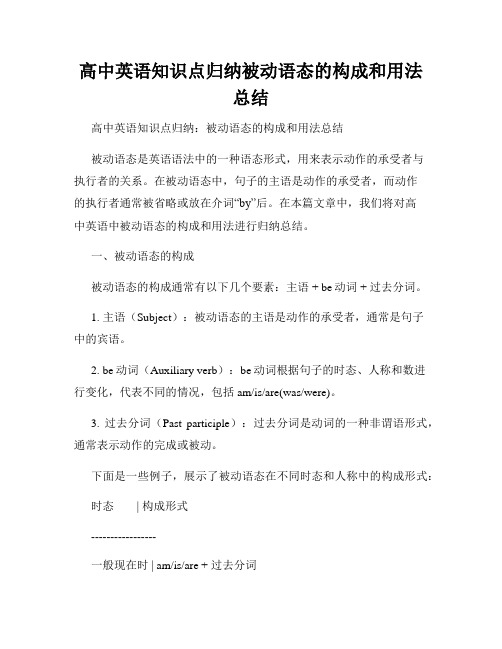
高中英语知识点归纳被动语态的构成和用法总结高中英语知识点归纳:被动语态的构成和用法总结被动语态是英语语法中的一种语态形式,用来表示动作的承受者与执行者的关系。
在被动语态中,句子的主语是动作的承受者,而动作的执行者通常被省略或放在介词“by”后。
在本篇文章中,我们将对高中英语中被动语态的构成和用法进行归纳总结。
一、被动语态的构成被动语态的构成通常有以下几个要素:主语 + be动词 + 过去分词。
1. 主语(Subject):被动语态的主语是动作的承受者,通常是句子中的宾语。
2. be动词(Auxiliary verb):be动词根据句子的时态、人称和数进行变化,代表不同的情况,包括am/is/are(was/were)。
3. 过去分词(Past participle):过去分词是动词的一种非谓语形式,通常表示动作的完成或被动。
下面是一些例子,展示了被动语态在不同时态和人称中的构成形式:时态 | 构成形式-----------------一般现在时 | am/is/are + 过去分词一般过去时 | was/were + 过去分词一般将来时 | will be + 过去分词现在进行时 | am/is/are + being + 过去分词过去进行时 | was/were + being + 过去分词现在完成时 | have/has been + 过去分词过去完成时 | had been + 过去分词二、被动语态的用法被动语态在英语中有着广泛的应用。
以下是几种常见的使用情况:1. 强调动作的承受者:被动语态可以突出句子中动作的承受者,使其成为句子的主要焦点。
例如:- The house was destroyed by the earthquake.(房子被地震摧毁了。
) - The book was written by a famous author.(这本书是由一位著名作家写的。
)2. 描述客观事实:当注重描述客观事实时,被动语态可以更加准确地传达信息。
被动语态知识点总结
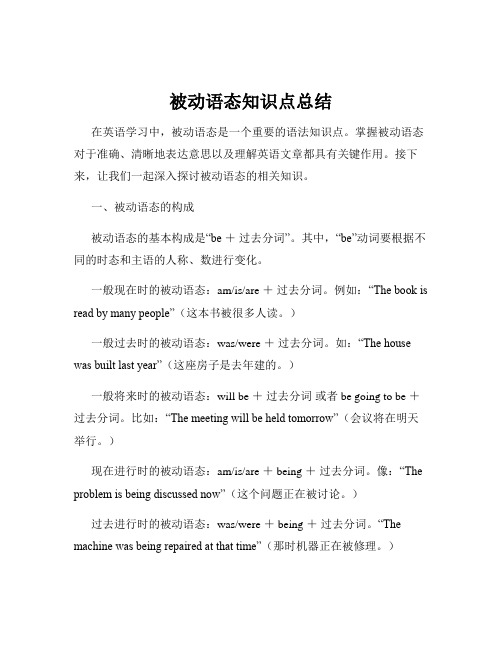
被动语态知识点总结在英语学习中,被动语态是一个重要的语法知识点。
掌握被动语态对于准确、清晰地表达意思以及理解英语文章都具有关键作用。
接下来,让我们一起深入探讨被动语态的相关知识。
一、被动语态的构成被动语态的基本构成是“be +过去分词”。
其中,“be”动词要根据不同的时态和主语的人称、数进行变化。
一般现在时的被动语态:am/is/are +过去分词。
例如:“The book is read by many people”(这本书被很多人读。
)一般过去时的被动语态:was/were +过去分词。
如:“The house was built last year”(这座房子是去年建的。
)一般将来时的被动语态:will be +过去分词或者 be going to be +过去分词。
比如:“The meeting will be held tomorrow”(会议将在明天举行。
)现在进行时的被动语态:am/is/are + being +过去分词。
像:“The problem is being discussed now”(这个问题正在被讨论。
)过去进行时的被动语态:was/were + being +过去分词。
“The machine was being repaired at that time”(那时机器正在被修理。
)现在完成时的被动语态:have/has been +过去分词。
“The work has been finished”(工作已经完成了。
)过去完成时的被动语态:had been +过去分词。
“The task had been completed before he came”(在他来之前任务已经完成了。
)二、被动语态的使用场景1、不知道动作的执行者是谁。
例如:“The window was broken last night”(窗户昨晚被打破了,但不知道是谁打破的。
)2、强调动作的承受者。
高中英语知识点归纳被动语态
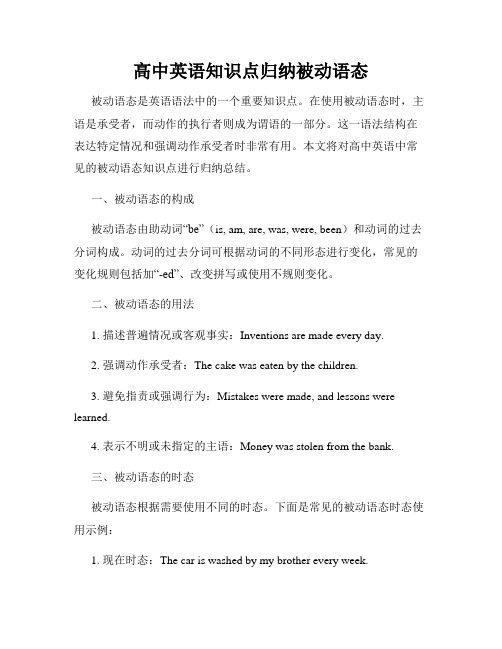
高中英语知识点归纳被动语态被动语态是英语语法中的一个重要知识点。
在使用被动语态时,主语是承受者,而动作的执行者则成为谓语的一部分。
这一语法结构在表达特定情况和强调动作承受者时非常有用。
本文将对高中英语中常见的被动语态知识点进行归纳总结。
一、被动语态的构成被动语态由助动词“be”(is, am, are, was, were, been)和动词的过去分词构成。
动词的过去分词可根据动词的不同形态进行变化,常见的变化规则包括加“-ed”、改变拼写或使用不规则变化。
二、被动语态的用法1. 描述普遍情况或客观事实:Inventions are made every day.2. 强调动作承受者:The cake was eaten by the children.3. 避免指责或强调行为:Mistakes were made, and lessons were learned.4. 表示不明或未指定的主语:Money was stolen from the bank.三、被动语态的时态被动语态根据需要使用不同的时态。
下面是常见的被动语态时态使用示例:1. 现在时态:The car is washed by my brother every week.2. 过去时态:The letter was sent yesterday.3. 将来时态:The contract will be signed next week.4. 现在进行时态:The house is being built by a group of workers.5. 现在完成时态:The book has been read by many people.四、被动语态与不定式、情态动词的使用1. 被动语态与不定式:The house needs to be repaired.2. 被动语态与情态动词:The project should be completed by tomorrow.五、被动语态的特殊情况1. 特殊疑问句:Where was the bag found?2. 感叹句:How beautifully the song was sung by the singer!3. 含有两个宾语的句子:We were given a gift by our friends.六、被动语态中的常见错误1. 错误的主语:The book is written by Shakespeare.(改为“The book was written by Shakespeare.”)2. 错误的时态:The photos were taken by me last weekend.(改为“The photos have been taken by me.”)通过对高中英语被动语态知识点的归纳总结,我们可以更好地理解和应用被动语态。
高中英语知识点归纳被动语态的构成和用法

高中英语知识点归纳被动语态的构成和用法被动语态是英语语法中常用的一个句子结构,被动语态的构成和用法对于学习英语的学生来说非常重要。
本文将就高中英语知识点归纳被动语态的构成和用法进行详细解析,帮助学生更好地掌握这个语法结构。
一、被动语态的构成被动语态的构成由两部分组成:be动词的各种时态形式和过去分词。
根据主句的时态和语态,be动词的形式会相应发生变化。
1. 现在时态的被动语态构成方式:主动语态:主语 + 动词(to be) + 过去分词被动语态:主语 + am/is/are + 过去分词2. 过去时态的被动语态构成方式:主动语态:主语 + 动词(to be) + 过去分词被动语态:主语 + was/were + 过去分词3. 将来时态的被动语态构成方式:主动语态:主语 + 动词(to be) + going to + 过去分词被动语态:主语 + will be + 过去分词4. 现在完成时态的被动语态构成方式:主动语态:主语 + have/has + 过去分词被动语态:主语 + have/has been + 过去分词二、被动语态的用法被动语态主要用来强调动作的承受者,或表达客观事实,又或者在不知道或想隐瞒动作执行者时使用。
下面将介绍被动语态的常见用法:1. 及物动词的被动语态:及物动词是指需要宾语才能完整表达意思的动词,常见的及物动词有:write, read, eat, drink等。
在被动语态中,及物动词的宾语变成主语,而原来的主语则成为介词"by"引导的短语。
例句:Active: John wrote a letter.(约翰写了一封信。
)Passive: A letter was written by John.(一封信被约翰写了。
)2. 不及物动词的被动语态:不及物动词是指没有宾语的动词,如:arrive, come, go等。
这类动词在被动语态中的主语仍然是动作的承受者,同样需要使用be动词的相应时态形式和过去分词构成。
(完整word)高中英语被动语态讲解与练习(含答案)-推荐文档

高中英语被动语态总结一、被动语态的构成形式1.被动语态的基本时态变化被动语态通常为十种时态的被动形式.被动语态由be+过去分词构成, be随时态的变化而变化。
以do为例, 各种时态的被动语态形式为:1.am/is/ar.+don.(过去分词.一般现在时. 2.ha./hav.bee.don.现在完成时3.am/i./ar.bein.don.现在进行时4.was/wer.don.一般过去时5.ha.bee.don.过去完成时6.was/wer.bein.don.过去进行时7.shall/wil.b.don.一般将来时8.should/woul.b.don.过去将来时9.shall/wil.hav.bee.don.将来完成时(少用)10.should/woul.hav.bee.don.过去将来完成时(少用)2.被动语态的特殊结构形式1)带情态动词的被动结构。
其形式为: 情态动词+be+过去分词。
例Th.bab.shoul.b.take.goo.car.o.b.th.baby-sitter.2.有些动词可以有两个宾语, 在用于被动结构时, 可以把主动结构中的一个宾语变为主语, 另一宾语仍然保留在谓语后面。
通常变为主语的是间接宾语。
例Hi.mothe.gav.hi..presen.fo.hi.birthday.可改.H.wa.give..presen.b.hi.mothe.fo.hi.birthday.3.当“动词+宾语+宾语补足语”结构变为被动语态时, 将宾语变为被动结构中的主语, 其余不动。
例Someon.caugh.th.bo.smokin..cigarette.可改为Th.bo.wa.caugh.smokin..cigarette.4)在使役动词have.make.get以及感官动词see.watch.notice.hear.feel.observe等后面不定式作宾语补语时, 在主动结构中不定式to要省略, 但变为被动结构时, 要加to。
高一英语语法重点总结 - 被动语态
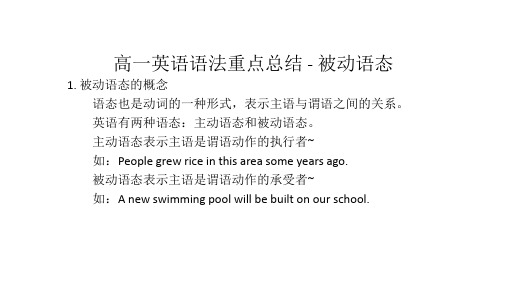
3. 被动语态的构成 • 被动语态的形式是由“助动词be+动词的过去分词”构成。助动词be随着主 语的人称、数、时态和语气的不同而变化。 • 各种时态的被动语态形式如下: • 1. 一般现在时 am/is/are+V(p.p) Electricity is used to run machines. 人们利 用电能运转机器。 • 2. 一般过去时 was/were + V(p.p) • Many trees were planted on the hill yesterday. 昨天我们在山坡上种了许多 树。 • 3. 一般将来时 will/shall +be+V(p.p) A sports meeting will be held next week. 下星期我们将举行一场运动会。 • 4. 过去将来时 should/would +be+V(p.p) • We were told that a big reservoir would be built in his hometown. 他告诉我 们人们将在他家乡建一个大水坝。
2. 被动语态的使用时机 • 被动语态的使用往往不是任意的,而是按照表达思想,描述事物的需要, 通常在下列情况下使用被动语态。
• • • • • • •
1. 不知道或不必说出动作的执行者。 This book has been translated into many languages. 这本书已被翻译成 许多种语言。 2. 动作的对象是谈话的中心。 A new railway will be built in our hometown. 我们家乡将建一条新铁路。 3. 修辞的需要,为了使句子更加简练匀称。 He appeared on the stage and was warmly applauded by the audience. 他出现在舞台上受到了观众的热烈欢迎。 注:被动语态便于论述客观事实,故常用于科技文章,新闻报道, 书刊介绍及景物描写。
高中英语知识点归纳被动语态的用法及常见情况

高中英语知识点归纳被动语态的用法及常见情况高中英语知识点归纳:被动语态的用法及常见情况被动语态是英语语法中的一种重要形式,它在句子中的作用是强调动作的接受者或者暗示动作的发出者。
被动语态的结构由“be”动词的不同形式加上及物动词的过去分词构成。
本文将归纳总结高中英语中被动语态的用法及常见情况,旨在帮助学生掌握被动语态的正确使用。
一、被动语态的构成被动语态的构成主要由以下三个要素组成:1. 助动词:be动词的各种形式(am, is, are, was, were, been);2. 主语:表示动作的承受者;3. 过去分词:动词的过去分词形式。
例如,下面是被动语态的几个例子:1. The cake was eaten by Peter.(蛋糕被彼得吃了)2. The letter is being written by Mary.(信件正在被玛丽写)3. The car has been repaired by the mechanic.(汽车已被机修工修好)二、被动语态的使用情况被动语态在实际应用中有多种使用情况,下面将对其中常见的几个情况进行详细归纳。
1. 表示无生命的主动词没有被执行者当动作的执行者无需指明时,可以使用被动语态。
例如:The window was broken.(窗户被打破了)The money was stolen.(钱被偷了)The book is written in English.(这本书是用英语写的)2. 表示强调动作承受者被动语态可以用来强调动作的接受者,使其成为句子的焦点。
例如:The cake was eaten by Peter.(蛋糕被彼得吃了)The letter was read by everyone.(信件被每个人都读了)3. 表示善意或委婉的表达被动语态可用于委婉表达,避免直接指责或责备别人。
例如:Mistakes were made.(有错误发生了)Machines are being used to replace human labor.(机器正在被使用来替代人力劳动)4. 某些固定句型中的被动语态被动语态在某些固定句型中的应用较为常见,例如:It is said that...(据说...)It is believed that...(人们相信...)It is known that...(众所周知...)三、被动语态的时态与语态转换被动语态的时态同主动语态一样,可根据具体情况来确定。
高中英语知识点归纳动词的被动语态
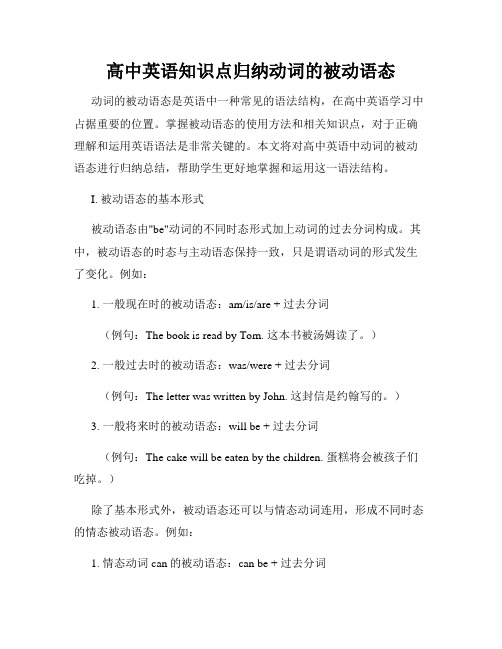
高中英语知识点归纳动词的被动语态动词的被动语态是英语中一种常见的语法结构,在高中英语学习中占据重要的位置。
掌握被动语态的使用方法和相关知识点,对于正确理解和运用英语语法是非常关键的。
本文将对高中英语中动词的被动语态进行归纳总结,帮助学生更好地掌握和运用这一语法结构。
I. 被动语态的基本形式被动语态由"be"动词的不同时态形式加上动词的过去分词构成。
其中,被动语态的时态与主动语态保持一致,只是谓语动词的形式发生了变化。
例如:1. 一般现在时的被动语态:am/is/are + 过去分词(例句:The book is read by Tom. 这本书被汤姆读了。
)2. 一般过去时的被动语态:was/were + 过去分词(例句:The letter was written by John. 这封信是约翰写的。
)3. 一般将来时的被动语态:will be + 过去分词(例句:The cake will be eaten by the children. 蛋糕将会被孩子们吃掉。
)除了基本形式外,被动语态还可以与情态动词连用,形成不同时态的情态被动语态。
例如:1. 情态动词can的被动语态:can be + 过去分词(例句:The problem can be solved by the teacher. 这个问题可以被老师解决。
)2. 情态动词should的被动语态:should be + 过去分词(例句:The car should be repaired by a professional mechanic. 这辆车应该由专业的机械师修理。
)II. 被动语态的用法1. 当我们不知道或不关心动作的执行者时,可以使用被动语态。
例如:(例句:The vase was broken. 这个花瓶被打破了。
)2. 当动作的承受者比执行者更重要或更值得强调时,可以使用被动语态。
例如:(例句:The cake was made by my grandmother.这个蛋糕是我奶奶做的。
高中英语知识点归纳被动语态和主动语态的区别及用法概述

高中英语知识点归纳被动语态和主动语态的区别及用法概述英语中的动词分为被动语态和主动语态。
被动语态强调动作的承受者,而主动语态则强调动作的执行者。
在高中英语学习中,准确地运用被动语态和主动语态是一项重要的能力。
本文将对被动语态和主动语态的区别及用法进行归纳概述,旨在帮助同学们更好地理解和运用这些知识点。
一、被动语态(Passive Voice)被动语态是指动作的接受者或者主体在句子中处于弱势地位,而执行动作的主体则没有明确表示或者放在句子末尾。
被动语态的构成主要由be动词的不同形式加上过去分词(past participle)完成。
被动语态的构成:主语 + be动词(am/is/are/was/were)+ 过去分词例如:- The cake was eaten by me.(蛋糕被我吃了。
)- The book is written by her.(这本书是她写的。
)被动语态的特点:1. 强调动作的接受者,相对主动语态较被动。
2. 句子中的主语通常不执行动作,而是承受动作。
3. 被动语态常用于强调行为的结果或者主语本身不重要的情况。
4. 时态和语态之间的转换需要根据上下文来决定。
被动语态的应用:1. 掌握被动语态的常用时态,如一般现在时态(am/is/are + 过去分词)、一般过去时态(was/were + 过去分词)、一般将来时态(will be + 过去分词)等。
2. 特定情况下需要强调动作的结果或者受事者时,采用被动语态更为得体。
例如:The house was built by the workers last month.(这座房子是上个月工人们建造的。
)3. 注意被动语态的时态和语态转换,合理运用不同的时态来表达不同的动作状态。
4. 被动语态可以通过去掉动作执行者,使句子更加简洁明了,并且避免句子中出现过多的重复内容。
二、主动语态(Active Voice)主动语态是指动作的执行者或者主体在句子中处于主导地位。
英语语法被动语态知识点梳理
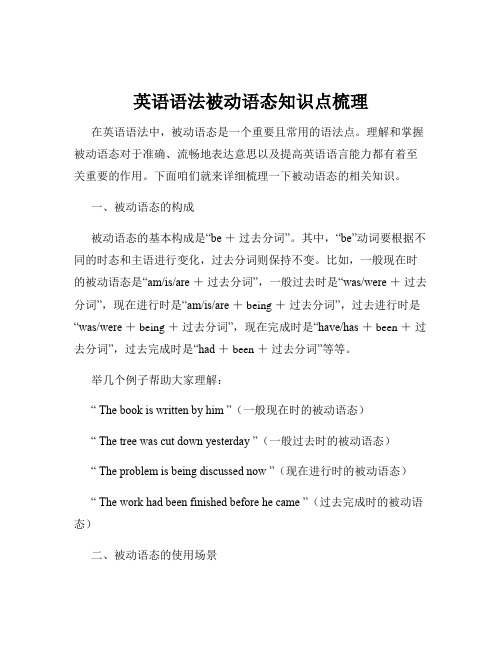
英语语法被动语态知识点梳理在英语语法中,被动语态是一个重要且常用的语法点。
理解和掌握被动语态对于准确、流畅地表达意思以及提高英语语言能力都有着至关重要的作用。
下面咱们就来详细梳理一下被动语态的相关知识。
一、被动语态的构成被动语态的基本构成是“be +过去分词”。
其中,“be”动词要根据不同的时态和主语进行变化,过去分词则保持不变。
比如,一般现在时的被动语态是“am/is/are +过去分词”,一般过去时是“was/were +过去分词”,现在进行时是“am/is/are + being +过去分词”,过去进行时是“was/were + being +过去分词”,现在完成时是“have/has + been +过去分词”,过去完成时是“had + been +过去分词”等等。
举几个例子帮助大家理解:“ The book is written by him ”(一般现在时的被动语态)“ The tree was cut down yesterday ”(一般过去时的被动语态)“ The problem is being discussed now ”(现在进行时的被动语态)“ The work had been finished before he came ”(过去完成时的被动语态)二、被动语态的使用场景1、不知道或没必要指出动作的执行者当我们关注的是动作本身而不是执行者时,就会使用被动语态。
例如:“The window was broken ”(不知道是谁打破了窗户)2、强调动作的承受者为了突出动作的承受者,会使用被动语态。
比如:“This song is loved by many people ”(强调很多人喜欢这首歌,而不是强调谁让很多人喜欢这首歌)3、出于礼貌或委婉在某些情况下,使用被动语态可以使表达更委婉、更礼貌。
比如:“It is suggested that you should come earlier ”(用被动语态比直接说“ We suggest that you should come earlier ”更委婉)三、主动语态变被动语态的方法1、把主动语态中的宾语变成被动语态的主语。
被动语态 被动语态的构成和用法

被动语态被动语态的构成和用法被动语态是英语中常用的一种语态,它用来表达动作的接受者,而不是执行者。
被动语态的构成和用法在英语语法中占据重要的位置。
本文将详细介绍被动语态的构成和用法,帮助读者更好地理解和运用被动语态。
一、被动语态的构成:被动语态的构成由be动词和过去分词构成。
be动词根据主语的不同形式而变化,过去分词则保持不变。
具体构成如下:1. 一般现在时的被动语态由am/is/are + 过去分词构成:- 主动语态:主语 + am/is/are + 动词原形 + 宾语- 被动语态:主语 + am/is/are + 过去分词 + by + 动作执行者(可省略)2. 一般过去时的被动语态由was/were + 过去分词构成:- 主动语态:主语 + was/were + 动词原形 + 宾语- 被动语态:主语 + was/were + 过去分词 + by + 动作执行者(可省略)3. 一般将来时的被动语态由will be + 过去分词构成:- 主动语态:主语 + will be + 动词原形 + 宾语- 被动语态:主语 + will be + 过去分词 + by + 动作执行者(可省略)4. 现在进行时的被动语态由am/is/are being + 过去分词构成:- 主动语态:主语 + am/is/are + 动词ing形式 + 宾语- 被动语态:主语 + am/is/are being + 过去分词 + by + 动作执行者(可省略)5. 过去进行时的被动语态由was/were being + 过去分词构成:- 主动语态:主语 + was/were + 动词ing形式 + 宾语- 被动语态:主语 + was/were being + 过去分词 + by + 动作执行者(可省略)二、被动语态的用法:被动语态在英语中具有以下几个常见的用法:1. 强调动作的接受者:被动语态可以使得动作的接受者成为句子的主语,突出强调动作的接受者。
高中英语被动语态知识点总结
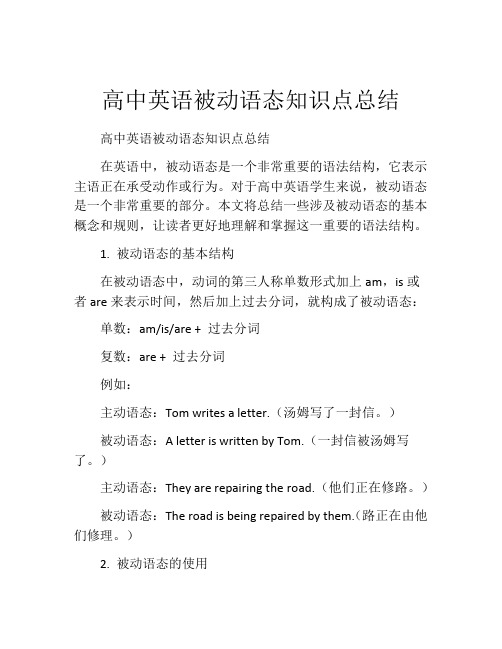
高中英语被动语态知识点总结高中英语被动语态知识点总结在英语中,被动语态是一个非常重要的语法结构,它表示主语正在承受动作或行为。
对于高中英语学生来说,被动语态是一个非常重要的部分。
本文将总结一些涉及被动语态的基本概念和规则,让读者更好地理解和掌握这一重要的语法结构。
1. 被动语态的基本结构在被动语态中,动词的第三人称单数形式加上am,is或者are来表示时间,然后加上过去分词,就构成了被动语态:单数:am/is/are + 过去分词复数:are + 过去分词例如:主动语态:Tom writes a letter.(汤姆写了一封信。
)被动语态:A letter is written by Tom.(一封信被汤姆写了。
)主动语态:They are repairing the road.(他们正在修路。
)被动语态:The road is being repaired by them.(路正在由他们修理。
)2. 被动语态的使用被动语态的使用有以下几个方面:2.1. 不知道或不必要提及执行动作的人或事物。
例如:The Mona Lisa was painted by Leonardo da Vinci.(蒙娜丽莎是由列奥纳多·达·芬奇绘制的。
)2.2. 强调对动作受到的影响或结果的重要性。
例如:The museum was destroyed in the fire.(博物馆在火灾中被摧毁了。
)2.3. 避免重复提到执行动作的人或事物。
例如:The book was stolen from the library.(这本书是从图书馆被偷的。
)2.4. 对执行动作的人或事物进行保密。
例如:The experiment will be carried out next month.(这项实验将于下个月进行。
)2.5. 在学术或科技文章中使用被动语态,以使文章听起来更专业。
例如:The theory was proven by the experiment.(该理论已经被实验证明了。
高中英语被动语态知识点总结
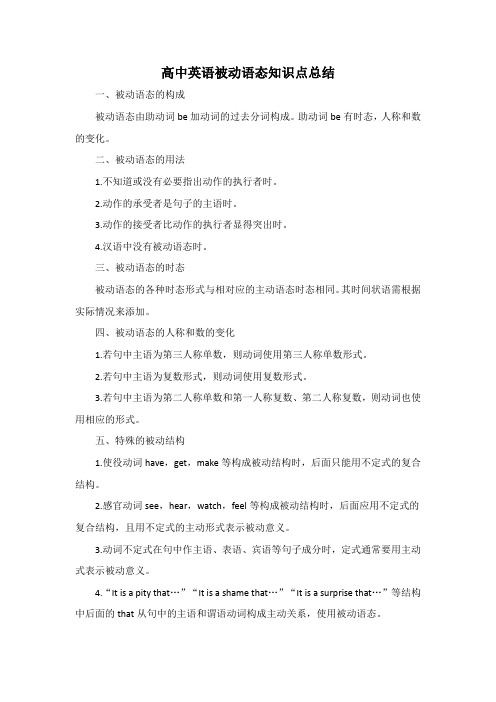
高中英语被动语态知识点总结
一、被动语态的构成
被动语态由助动词be加动词的过去分词构成。
助动词be有时态,人称和数的变化。
二、被动语态的用法
1.不知道或没有必要指出动作的执行者时。
2.动作的承受者是句子的主语时。
3.动作的接受者比动作的执行者显得突出时。
4.汉语中没有被动语态时。
三、被动语态的时态
被动语态的各种时态形式与相对应的主动语态时态相同。
其时间状语需根据实际情况来添加。
四、被动语态的人称和数的变化
1.若句中主语为第三人称单数,则动词使用第三人称单数形式。
2.若句中主语为复数形式,则动词使用复数形式。
3.若句中主语为第二人称单数和第一人称复数、第二人称复数,则动词也使用相应的形式。
五、特殊的被动结构
1.使役动词have,get,make等构成被动结构时,后面只能用不定式的复合结构。
2.感官动词see,hear,watch,feel等构成被动结构时,后面应用不定式的复合结构,且用不定式的主动形式表示被动意义。
3.动词不定式在句中作主语、表语、宾语等句子成分时,定式通常要用主动式表示被动意义。
4.“It is a pity that…”“It is a shame that…”“It is a surprise that…”等结构中后面的that从句中的主语和谓语动词构成主动关系,使用被动语态。
高中被动语态精华讲解
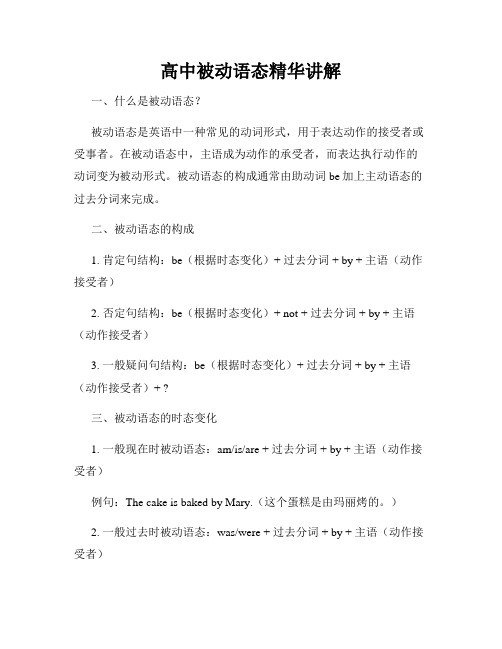
高中被动语态精华讲解一、什么是被动语态?被动语态是英语中一种常见的动词形式,用于表达动作的接受者或受事者。
在被动语态中,主语成为动作的承受者,而表达执行动作的动词变为被动形式。
被动语态的构成通常由助动词be加上主动语态的过去分词来完成。
二、被动语态的构成1. 肯定句结构:be(根据时态变化)+ 过去分词 + by + 主语(动作接受者)2. 否定句结构:be(根据时态变化)+ not + 过去分词 + by + 主语(动作接受者)3. 一般疑问句结构:be(根据时态变化)+ 过去分词 + by + 主语(动作接受者)+ ?三、被动语态的时态变化1. 一般现在时被动语态:am/is/are + 过去分词 + by + 主语(动作接受者)例句:The cake is baked by Mary.(这个蛋糕是由玛丽烤的。
)2. 一般过去时被动语态:was/were + 过去分词 + by + 主语(动作接受者)例句:The book was written by the famous author.(这本书是由这位著名作家写作的。
)3. 一般将来时被动语态:will be + 过去分词 + by + 主语(动作接受者)例句:The letter will be delivered by the postman.(这封信将会被邮递员送达。
)四、被动语态的用法1. 当我们不知道或不关心动作执行者时,使用被动语态。
例句:The car was stolen.(这辆车被盗了。
)2. 强调动作的承受者或受事者时,使用被动语态。
例句:The new stadium will be used for the Olympic Games.(新体育场将被用于奥运会。
)3. 在科学、新闻报道中常使用被动语态。
例句:A new vaccine has been developed by scientists.(科学家们研发出了一种新疫苗。
高中英语知识点归纳被动语态的构成和应用

高中英语知识点归纳被动语态的构成和应用被动语态是英语中一个重要的语法结构,对于高中英语学习而言也是必不可少的一部分。
在本文中,我们将归纳被动语态的构成和应用,希望能帮助大家更好地理解和运用被动语态。
一、被动语态的构成被动语态的构成一般由be动词的各种时态形式加上过去分词构成。
主动语态中的主语变为被动语态中的表语,而原来的宾语则成为被动语态中的主语。
例如:主动语态:They built a new hospital.被动语态:A new hospital was built by them.主动语态:He is cleaning the room.被动语态:The room is being cleaned by him.主动语态:She has written a novel.被动语态:A novel has been written by her.二、被动语态的应用1. 当我们不知道动作的执行者是谁或者不重要时,可以使用被动语态。
例如:The cake was eaten.(蛋糕被吃了。
)2. 当我们想强调动作的承受者时,可以使用被动语态。
例如:The letter was written by my sister.(这封信是我妹妹写的。
)3. 当我们描述一系列类似的动作和事件时,为了避免重复使用主语,可以使用被动语态。
例如:The books were taken from the library, the shelves were cleaned, and the floors were mopped.(图书馆的书被拿走了,货架被清洁了,地板被拖了。
)4. 当我们描述自然现象或普遍事实时,可以使用被动语态。
例如:The sun is worshipped by many cultures.(太阳被许多文化崇拜。
)5. 当我们在科学、新闻或学术写作中描述研究方法、实验结果或观察时,可以使用被动语态。
高中英语语法——被动语态用法归纳
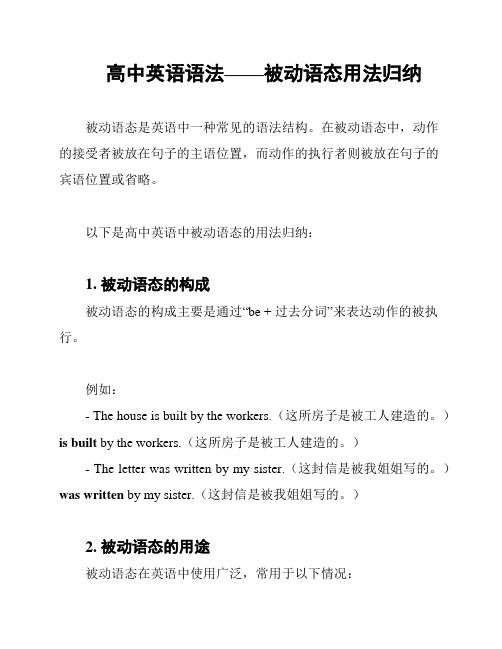
高中英语语法——被动语态用法归纳被动语态是英语中一种常见的语法结构。
在被动语态中,动作的接受者被放在句子的主语位置,而动作的执行者则被放在句子的宾语位置或省略。
以下是高中英语中被动语态的用法归纳:1. 被动语态的构成被动语态的构成主要是通过“be + 过去分词”来表达动作的被执行。
例如:- The house is built by the workers.(这所房子是被工人建造的。
)is built by the workers.(这所房子是被工人建造的。
)- The letter was written by my sister.(这封信是被我姐姐写的。
)was written by my sister.(这封信是被我姐姐写的。
)2. 被动语态的用途被动语态在英语中使用广泛,常用于以下情况:- 当动作的执行者不明确或不重要时。
例如:- The cake was eaten.(这个蛋糕被吃了。
)(动作的执行者不明确)was eaten.(这个蛋糕被吃了。
)(动作的执行者不明确)- The book is written in English.(这本书是用英语写的。
)(动作的执行者不重要)is written in English.(这本书是用英语写的。
)(动作的执行者不重要)- 当强调动作的接受者或结果时。
例如:- The city was destroyed by the earthquake.(这个城市被地震摧毁了。
)(强调结果)was destroyed by the earthquake.(这个城市被地震摧毁了。
)(强调结果)- The painting was done by a famous artist.(这幅画是由一位著名艺术家完成的。
)(强调接受者)was done by a famous artist.(这幅画是由一位著名艺术家完成的。
)(强调接受者)3. 被动语态与时态被动语态使用与相应时态的被动形式。
动词的被动语态
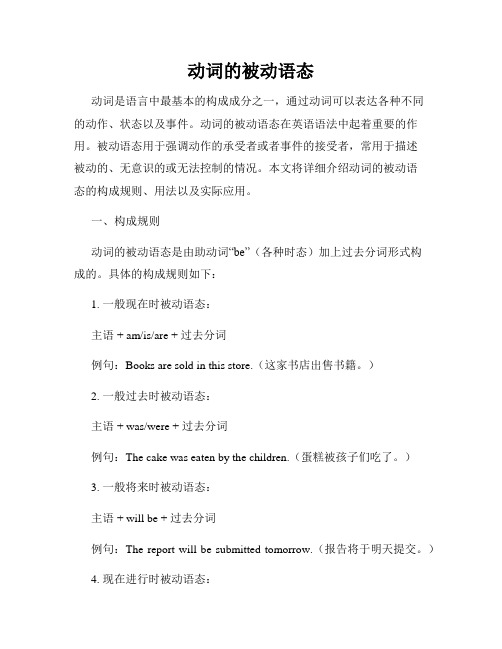
动词的被动语态动词是语言中最基本的构成成分之一,通过动词可以表达各种不同的动作、状态以及事件。
动词的被动语态在英语语法中起着重要的作用。
被动语态用于强调动作的承受者或者事件的接受者,常用于描述被动的、无意识的或无法控制的情况。
本文将详细介绍动词的被动语态的构成规则、用法以及实际应用。
一、构成规则动词的被动语态是由助动词“be”(各种时态)加上过去分词形式构成的。
具体的构成规则如下:1. 一般现在时被动语态:主语 + am/is/are + 过去分词例句:Books are sold in this store.(这家书店出售书籍。
)2. 一般过去时被动语态:主语 + was/were + 过去分词例句:The cake was eaten by the children.(蛋糕被孩子们吃了。
)3. 一般将来时被动语态:主语 + will be + 过去分词例句:The report will be submitted tomorrow.(报告将于明天提交。
)4. 现在进行时被动语态:主语 + am/is/are + being + 过去分词例句:The house is being cleaned by the maid.(房子正在被女佣打扫。
)5. 过去进行时被动语态:主语 + was/were + being + 过去分词例句:The car was being repaired when the accident happened.(事故发生时汽车正在维修。
)6. 现在完成时被动语态:主语 + have/has been + 过去分词例句:The movie has been watched by millions of people.(这部电影已经被数百万人观看了。
)7. 过去完成时被动语态:主语 + had been + 过去分词例句:The work had been completed before the deadline.(工作在截止日期之前已经完成了。
- 1、下载文档前请自行甄别文档内容的完整性,平台不提供额外的编辑、内容补充、找答案等附加服务。
- 2、"仅部分预览"的文档,不可在线预览部分如存在完整性等问题,可反馈申请退款(可完整预览的文档不适用该条件!)。
- 3、如文档侵犯您的权益,请联系客服反馈,我们会尽快为您处理(人工客服工作时间:9:00-18:30)。
高一英语语法(4):动词的被动语态一、常见的被动语态形式主动语态:A do B被动语态:B + be + done + (by A);A承受者;B执行者1. 以repair为例,写出以下时态的被动语态2. 情态动词的被动语态(情态动词+ be + done)*被动语态的时态是通过助动词be来体现的,与其后的done无关。
3. E.X.1)You __________ (be, want) on the phone.有电话找你。
2)The city __________ (be, liberate) in 1949. 这座城市是1949年解放的。
3)They __________ (be,invite) to your party.他们将被邀请参加你的晚会。
4)The car ___________ (be, repair). 车正在修理当中5)This book __________ (be, translate) into many languages. 这本书已被译成多种语言。
6)The worker said that the tree __________ (be plant). 工人说要把树种上。
7)The door __________ (be, paint) then. 那时,那道门正在被刷漆。
8)The work __________ (be, finish) before dark.天黑前工作就完成了。
9)The work __________ (be, do) today.10)His house __________ (be, sell). 他的房子卖掉了。
11)His house __________ (be, sell) so that he doesn’t have any house to live in. 他二、被动语态的基本用法(承受者和执行者)1.当强调动作的承受者,将承受者作为谈话的中心时用被动语态。
如:2.当没有必要说出动作的执行者或根本不知道动作的执行者是谁时通常用被动语态。
如:(be, finish)by now.3.当动作的执行者不是人而是无生命的事物时常用被动语态。
如:4.有时出于礼貌,不便提到动作的执行者,用被动语态。
如:Enough __________ (be, do) for you, but you’ve made little progress.为你做了很多,然而你却进步很少。
(谦虚)三、较为特殊的被动语态结构1. 感官动词和使役动词的被动语态doing(现在分词,表正在)1)A + see/hear/notice/find/watch/observe + Bdo(不带to的不定式,表过程)B + be + seen / heard / noticed / found / watched / observed + to do(动词不定式)2)A + let / have / make + B + do(不带to的不定式)B + be let / had / made + to do(动词不定式)如:He was seen __________ (enter) the room.2. 带复合宾语的动词在改为被动语态时,常把主动结构中的宾语改为主语,而宾语补足语保留不动。
*双宾语:vt. + 间接宾语+ 直接宾语双宾语*复合宾语:vt. + 宾语+ 宾语补足语(宾补)复合宾语宾语+ be done + 宾语补足语(宾补)sb. be told to do如:Mrs. Smith warned her daughter never to drive after drinking.vt. 宾语宾语补足语(宾补)Mrs. Smith’s daughter __________ (be, warn) __________.主语3. 短语动词变为被动语态时,把主要动词变为被动形式。
如:The old houses __________.4. 汉语有一类句子不出现主语(无主语主动句),在英语中可用被动结构表示。
如:It is said that…据说……It is reported that…据报道……It is supposed that…据推测……It is hoped that…希望……It is well known that…众所周知……It is generally considered that…普遍认为……It is suggested that…有人建议……__________ he is famous in his own country.四、主动形式表示被动意义1.表示事物状态特征的连系动词看起来/听起来/摸起来/闻起来/尝起来:look, sound, feel, smell, taste似乎:appear, seem证明:prove变得:go, turn, become, get, grow, + adj. 保持:keep, stayfall(fall asleep)如:The flowers __________ sweet.2.表示主语的某种属性特征的动词read, write, act, iron, cut, draw, drive, sell,wash, clean, wear, open, cook, lock, shut, dry, eat, drink + adv. 如:1)This pen __________ well.2)The coat __________ conveniently.3)This book __________ well. 。
3.表示开始、结束、运动的动词,如:begin, finish, start, open, close, stop, end,shut, run(运行), move等。
如:Work __________ at 8 o’cloc k this morning. 工作在今天早上84.“in, on, under等+ n.”构成prep.短语表被动意义,名词前一般不用冠词(介词的固定搭配)。
如:under control(被控制住), under repair(在修理中), under discussion(在讨论中), under construction(在修建中), beyond belief (难以置信), beyon d one’s reach(够不着), beyond our hope(始料不及), for sale(热销中), for rent(以供出租), in print(已出版), on show(上演,被展示), on trial(受审;在试验中), out of fashion(过时),in sight (被看见), out of sight(___________)等。
如:The bike is __________.5.1) sth. be worth + doing sth.2) sth. need / want / require + sth.to be done如:1)The newspaper is worth __________ (read).2)This bicycle needs __________ (repair).= This bicycle needs __________ __________ __________.6.有些adj.后的to do(动词不定式)有被动的含义。
这些adj.构成的句型为:A很容易/难/重/轻/合适/如:The work is hard __________ (do). 这项工作很难做。
7.too + adj. 原级adj. 原级+ enough + to do如:The story was not interesting enough __________ (publish).这个故事趣味性不够,不能(被)发表。
8.在“A + have + B + to do”的结构中,当to do与它修饰的B有动宾关系,且与该句的A构成逻辑上的主谓关系时,to do一般用主动形式表被动;反之,需使用to be done的结构表明被动。
如:主谓She has a sister to look after.动宾主谓A haveB to do动宾1)He has nothing __________ (eat). 他没有什么东西可吃。
2)Do you see the letter __________ (type)? 你看到那封要打的信了吗?3)Do you have much work __________(do) today? 你今天有很多工作要做吗?9.某些动词在以物为主语的句子中,其进行时也可以表示被动意义。
如:The dinner is cooking. 正在烧饭。
五、被动语态与系表结构的区别:被动语态表示动作,主语是动作的承受者;系表结构表示主语的特征或所处的状态。
1. A be done by B:被动语态;A be done __________ (其他prep.搭配):系表结构。
如:1)(被动语态)2)I was frightened of snake. 我怕蛇。
系+ 表(动词的过去分词做adj.,做系动词的表语,表状态)2.am / is / are + done +am / is / are + done:系表结构。
如:1)银行通常在6点(被)关门。
(被动语态)2)The bank is now closed. 银行现在没开门。
系+ 表3.was / were + done +was / were + done:系表结构。
如:1)这幅画是很久以前(被)画的。
(被动语态)2)The picture was drawn well. 这幅画画得很好。
系+ 表六、“get + done”结构的用法1.表示突然、偶然、意外发生的事。
如:The student got __________ (hurt)onhis way home from school.2.表示反身行为而非被动行为。
如:I have to get __________ (dress)before 7o’clock. 73.表示说话强调动作。
比较:1)Were you invited to the party?2)Did you get invited to the party?4.这种结构比较常见的搭配有:get arrested(被捕), get caught(被抓到), getconfused(发蒙), get delayed(被推迟了), get engaged(订婚),get married (结婚了),get divorced(离婚了), get dressed(穿好衣服), get drowned (被淹死了), get drunk(喝醉了), get elected(获得选票), get hit(挨打), get killed(毙命), get lost(迷路), get stuck(卡住了)。
